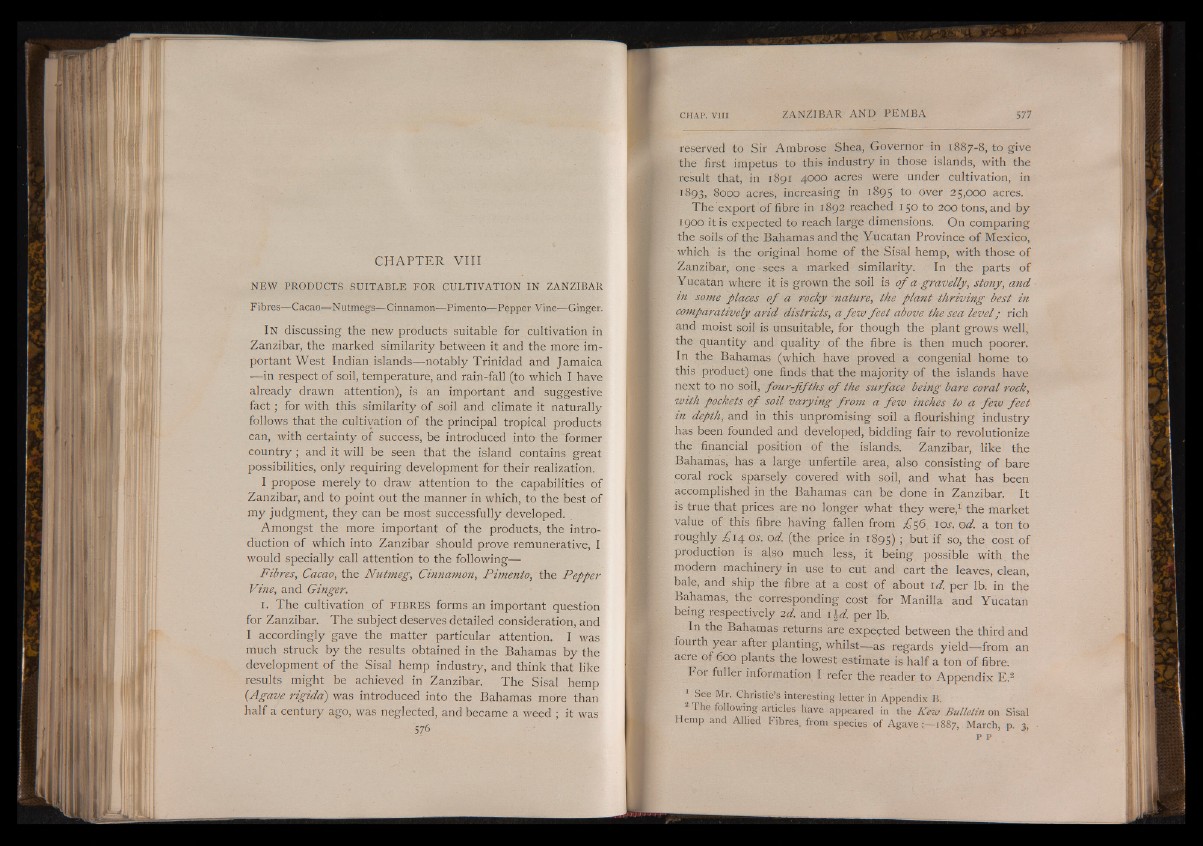
CHAPTER VIII
NEW PRODUCTS SUITABLE FOR CULTIVATION IN ZANZIBAR
Fibres— Cacao— Nutmegs— Cinnamon— Pimento— Pepper Vine— Ginger.
In discussing the new products suitable for cultivation in
Zanzibar, the marked similarity between it and the more important
West Indian islands— notably Trinidad and Jamaica
— in respect of soil, temperature, and rain-fall (to which I have
already drawn attention), is an important arid suggestive
fa c t; for with this similarity of soil and climate it naturally
follows that the cultivation of the principal tropical products
can, with certainty of success, be introduced into the former
country; and it will be seen that the island contains great
possibilities, only requiring development for their realization.
I propose merely to draw attention to the capabilities of
Zanzibar, and to point out the manner in which, to the best of
my judgment, they can be most successfully developed.
Amongst the more important of the products, the introduction
of which into Zanzibar should prove remunerative, I
would specially call attention to the following—
Fibres, Cacao, the Nutmeg, Cinnamon, Pimento, the Pepper
Vine, and Ginger.
i. The cultivation of f ib r e s forms an important question
for Zanzibar. The subject deserves detailed consideration, and
I accordingly gave the matter particular attention. I was
much struck by the results obtained in the Bahamas by the
development of the Sisal hemp industry, and think that like
results might be achieved in Zanzibar. The Sisal hemp
(Agave rigida) was introduced into the Bahamas more than
half a century ago, was neglected, and became a weed ; it was
576
reserved to Sir Ambrose Shea, Governor in 1887-8, to give
the first impetus to this industry in those islands, with the
result that, in 1891 4000 acres were under cultivation, in
1893, 8000 acres, increasing in 1895 to over 25,000 acres.
The export of fibre in 1892 reached 150 to 200 tons, and by
1900 it is expected to reach large dimensions. On comparing
the soils of the Bahamas and the Yucatan Province of Mexico,
which is the original home of the Sisal hemp, with those of
Zanzibar, one sees a marked similarity. In the parts of
Yucatan where it is grown the soil is o f a gravelly, stony, and
tn some places o f a rocky 'nature, the plant thriving best in
comparatively arid districts, a few feet above the sea level; rich
and moist soil is unsuitable, for though the plant grows well,
the quantity and quality of the fibre is then much poorer.
In the Bahamas (which have proved a congenial home to
this product) one finds that the majority of the islands have
next to no soil, four-fifths o f the surface being bare coral rock,
with pockets o f soil varying from a few inches to a few feet
in depth, and in this unpromising soil a flourishing industry
has been founded and developed, bidding fair to revolutionize
-the financial position of the islands. Zanzibar, like the
Bahamas, has a large unfertile area, also consisting of bare
coral rock sparsely covered with soil, and what has been
accomplished in the Bahamas can be done in Zanzibar. It
is true that prices are no longer what they were,1 the market
value of this fibre having fallen from £56 i o l o d . a ton to
roughly £14 or. od. (the price in 1895) ; but if so, the cost of
production is also much less, it being possible with the
modern machinery in use to cut and cart the leaves, clean,
bale, and ship the fibre at a cost of about id. per lb. in the
Bahamas, the corresponding cost for Manilla and Yucatan
being respectively 2d. and ¡ ¡ ¡ j per lb.
In the Bahamas returns are expected between the third and
fourth year after planting, whilst— as regards yield— from an
acre of 600 plants the lowest estimate is half a ton of fibre.
For fuller information I refer the reader to Appendix E.2
* See Mr. Christie’s interesting letter in Appendix B.
The following articles have appeared in the Kew Bulletin on Sisal
Hemp and Allied Fibres, from species of Agave 18 8 7 , March, p. 3,
P P